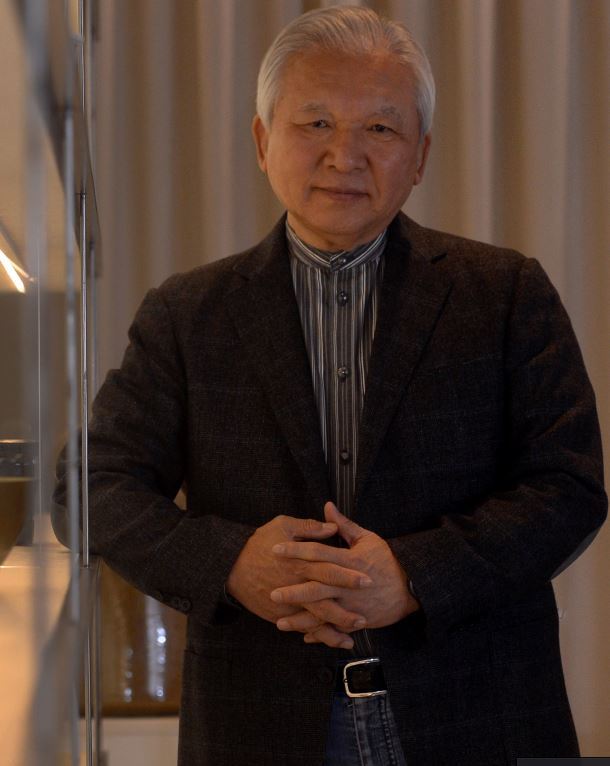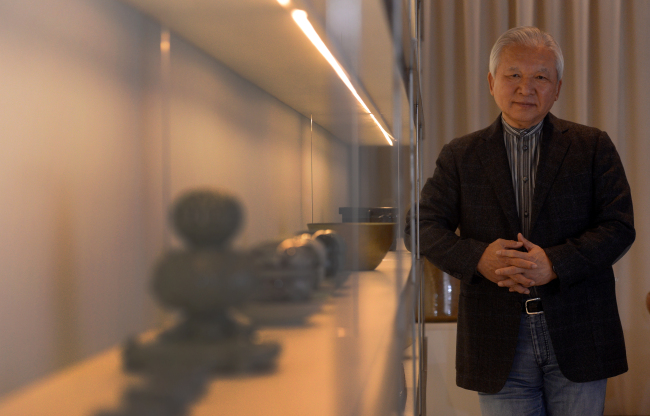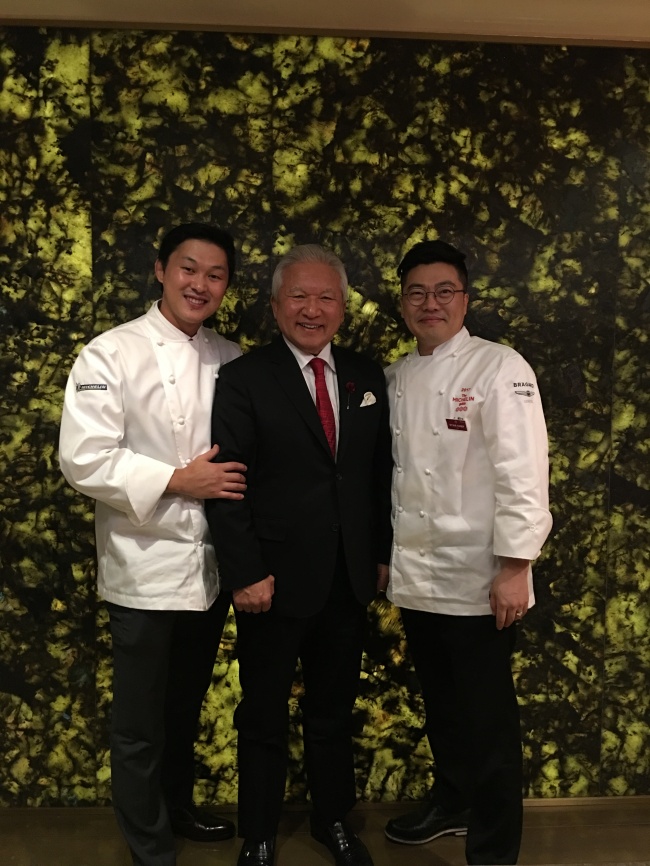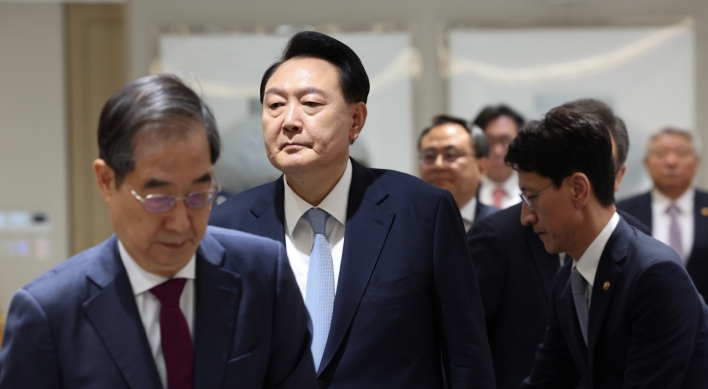[Newsmaker] Hansik champion talks on Michelin success
One man’s tireless crusade for fine Korean cuisine earns his restaurants Michelin stars
By Korea HeraldPublished : Nov. 18, 2016 - 18:41
Extending his hand in a handshake, Cho Tae-kwon, chairman of KwangJuYo, smiles broadly.

Cho has every reason to be smiling. His two restaurants had been awarded much coveted Michelin stars earlier in the week: Gaon, a Korean fine-dining restaurant in Sinsa-dong helmed by chef Kim Byeong-jin, received three stars while Bicena, the more casual sister to Gaon in Hannam-dong, where chef Bang Ki-su presides, was given one star.
For those familiar with Cho’s passionate and relentless efforts to establish the concept of Korean fine dining, the Michelin stars seem well-earned recognition.

“Heaven helps those who help themselves,” said Cho on Nov. 11 at Gaon, reflecting on the feat of having two Michelin starred restaurants in one city. “The goal was to get three stars but there was no way of knowing whether we would get a star or not.”
The implications of having Korean restaurants earn three Michelin stars in the guidebook’s inaugural Seoul edition is immense, according to Cho. La Yeon of the Shilla Seoul Hotel also received three stars.
“It means that the world has recognized Korean cuisine. And now there is a channel for Korean cuisine to enter the world market,” Cho said in his authoritative voice. The Michelin stars also translate into respect for Korean cuisine, he said, arguing that Korean cuisine has often been relegated to cheap fare with generous servings of banchan.
Many Koreans, while willing to pay steep prices at Japanese or French restaurants, are indignant that Korean restaurants should charge similar price.
“For Koreans, Korean cuisine is something you eat at home every day. It is home cooking,” said Cho, hence the resistance to the very concept of Korean fine dining.
Cho is optimistic that the Michelin stars will change such perceptions and prejudices about Korean cuisine.
“It has set a standard. Also, it has given direction and confidence to the chefs,” he said.
The Michelin stars are vindication for Cho, who has long struggled to give Korean cuisine, or hansik, its proper value.
Cho, who inherited a fine porcelain business from his father, had a vision of creating food and wine that the vessels his company created would hold. After three years of careful preparations, he opened Gaon near Dosan Park. It was a pioneering effort at introducing the concept of fine dining for Korean cuisine. In 2007, Cho hosted a Korean dinner at Napa Valley, shipping all the tableware and ingredients for the gala dinner prepared by a staff of seven from Gaon. Sixty guests attended the event, including Napa Valley winery owners, gourmands and food columnists. Several leading figures in the Korean cultural scene were also invited.
“I wanted to show the epitome of Korean culture. I wanted to wow them with the best Korean taste and style. My ultimate goal was to shock the guests from Korea,” Cho recollects in his 2012 book on Korean cuisine. “I wanted to share my ideas and dreams with them through the Napa Valley event,” he writes.
While he deeply impressed the guests at the Napa Valley gala event, Gaon continued to meet with resistance from Koreans who balked at the reinterpretation traditional Korean food and the prices charged at the restaurant.
“People who are used to a meal costing 6,500 won were upset with our pricing,” he recalls in his book.
In 2008, Cho made the difficult choice of closing down Gaon. He also closed down all his other restaurants, including Gaon in China, which had been heralded as a case of globalization of hansik.
The implications of having Korean restaurants earn three Michelin stars in the guidebook’s inaugural Seoul edition is immense, according to Cho. La Yeon of the Shilla Seoul Hotel also received three stars.
“It means that the world has recognized Korean cuisine. And now there is a channel for Korean cuisine to enter the world market,” Cho said in his authoritative voice. The Michelin stars also translate into respect for Korean cuisine, he said, arguing that Korean cuisine has often been relegated to cheap fare with generous servings of banchan.
Many Koreans, while willing to pay steep prices at Japanese or French restaurants, are indignant that Korean restaurants should charge similar price.
“For Koreans, Korean cuisine is something you eat at home every day. It is home cooking,” said Cho, hence the resistance to the very concept of Korean fine dining.
Cho is optimistic that the Michelin stars will change such perceptions and prejudices about Korean cuisine.
“It has set a standard. Also, it has given direction and confidence to the chefs,” he said.
The Michelin stars are vindication for Cho, who has long struggled to give Korean cuisine, or hansik, its proper value.
Cho, who inherited a fine porcelain business from his father, had a vision of creating food and wine that the vessels his company created would hold. After three years of careful preparations, he opened Gaon near Dosan Park. It was a pioneering effort at introducing the concept of fine dining for Korean cuisine. In 2007, Cho hosted a Korean dinner at Napa Valley, shipping all the tableware and ingredients for the gala dinner prepared by a staff of seven from Gaon. Sixty guests attended the event, including Napa Valley winery owners, gourmands and food columnists. Several leading figures in the Korean cultural scene were also invited.
“I wanted to show the epitome of Korean culture. I wanted to wow them with the best Korean taste and style. My ultimate goal was to shock the guests from Korea,” Cho recollects in his 2012 book on Korean cuisine. “I wanted to share my ideas and dreams with them through the Napa Valley event,” he writes.
While he deeply impressed the guests at the Napa Valley gala event, Gaon continued to meet with resistance from Koreans who balked at the reinterpretation traditional Korean food and the prices charged at the restaurant.
“People who are used to a meal costing 6,500 won were upset with our pricing,” he recalls in his book.
In 2008, Cho made the difficult choice of closing down Gaon. He also closed down all his other restaurants, including Gaon in China, which had been heralded as a case of globalization of hansik.

Cho then shifted his focus to creating a premium soju brand, Hwayo.
“I hadn’t given up on the restaurant business. I envisioned Hwayo as a cash cow,” he said. It was a number of years before Hwayo turned profitable, with Korea’s alcohol tax system proving to be the biggest hurdle for the business.
In 2010, Cho began to host monthly dinners at his Seongbuk-dong residence, inviting opinion leaders and cultural figure heads. Prepared by Gaon chef Kim Byeong-jin, the project was an effort to prepare for the eventual reopening of Gaon.
In the meantime, his daughter Lucia Cho was put in charge of opening a casual modern Korean dining restaurant, Bicena in Hannam-dong. The restaurant opened in 2012 and quickly became a place for trendsetters and foreign visitors.
Three years later, in 2015, Lucia reopened Gaon at the Horim Art Center in Sinsa-dong, just a stone’s throw from the site of the original Gaon. It is an intimate and exclusive space with closed off dining rooms that is only open for dinner and offers two seasonal set meal options.
In March, Michelin announced that it would publish a Seoul edition of the Michelin Guide.
“All chefs felt urged on,” said Cho. From that moment on, all restaurants worth their name worked toward the same goal -- to be included in the venerated book of gourmands.
Cho had foreseen that the Michelin Guidebook would soon arrive in Seoul.
“Korean cuisine is still unexplored and Korea is a leading country culturally,” he says.
For Cho, preparations for the unannounced visit by a team of unidentified Michelin inspectors included sending his chefs abroad to experience fine dining for themselves.
Cho believes that there is no failure in business, only experience that you can build upon to achieve success. Similarly, he argues that there is no such thing as “premature” when it comes to culture. He is only too keenly aware of the criticisms hurled at him when he first opened Gaon. Some called it a foolhardy move, claiming that Korea was not ready for hansik fine dining.
“Closing Gaon was not a failure. It was only halted. Since Gaon, many Korean restaurants with similar concepts as Gaon have sprung up,” he said.
One of the innovations that he introduced here is the “open kitchen.” “This boosted the level of hygiene in the kitchens. It also elevated the status of chefs,” he said.
Despite its skeptics, Cho predicts that the influence of Michelin Guide in Korea will be felt far and wide.
“It will raise the quality of all restaurants and it will also bring up the quality of produce and ingredients,” said Cho, adding that this is a case where culture has an economic impact.
Cho is not anxious about maintaining the three-star status for Gaon. In his typically relaxed and confident manner, he said, “Even if you go down one star, you can come back up again.”
What does he envision for his restaurants in the next 10 years? “I am planning a restaurant chain business,” he said. A man who dreams big, he talks about Gaon in New York, Tokyo and Hong Kong as well as Bicena in 10 major cities around the world.
More immediately, Bicena will be opening on the 81st floor of the new Lotte World Tower in March. It will have 80 seats commanding a spectacular view of the city.
“It will be a very different business from its current location in Hannam-dong where most of the clients are Westerners. At Lotte, it will be a different crowd and it has the potential of becoming a tourist destination,” said Cho.
“My long term goal is to have the world eat hansik,” he said.
By Kim Hoo-ran (khooran@herald.com)
“I hadn’t given up on the restaurant business. I envisioned Hwayo as a cash cow,” he said. It was a number of years before Hwayo turned profitable, with Korea’s alcohol tax system proving to be the biggest hurdle for the business.
In 2010, Cho began to host monthly dinners at his Seongbuk-dong residence, inviting opinion leaders and cultural figure heads. Prepared by Gaon chef Kim Byeong-jin, the project was an effort to prepare for the eventual reopening of Gaon.
In the meantime, his daughter Lucia Cho was put in charge of opening a casual modern Korean dining restaurant, Bicena in Hannam-dong. The restaurant opened in 2012 and quickly became a place for trendsetters and foreign visitors.
Three years later, in 2015, Lucia reopened Gaon at the Horim Art Center in Sinsa-dong, just a stone’s throw from the site of the original Gaon. It is an intimate and exclusive space with closed off dining rooms that is only open for dinner and offers two seasonal set meal options.
In March, Michelin announced that it would publish a Seoul edition of the Michelin Guide.
“All chefs felt urged on,” said Cho. From that moment on, all restaurants worth their name worked toward the same goal -- to be included in the venerated book of gourmands.
Cho had foreseen that the Michelin Guidebook would soon arrive in Seoul.
“Korean cuisine is still unexplored and Korea is a leading country culturally,” he says.
For Cho, preparations for the unannounced visit by a team of unidentified Michelin inspectors included sending his chefs abroad to experience fine dining for themselves.
Cho believes that there is no failure in business, only experience that you can build upon to achieve success. Similarly, he argues that there is no such thing as “premature” when it comes to culture. He is only too keenly aware of the criticisms hurled at him when he first opened Gaon. Some called it a foolhardy move, claiming that Korea was not ready for hansik fine dining.
“Closing Gaon was not a failure. It was only halted. Since Gaon, many Korean restaurants with similar concepts as Gaon have sprung up,” he said.
One of the innovations that he introduced here is the “open kitchen.” “This boosted the level of hygiene in the kitchens. It also elevated the status of chefs,” he said.
Despite its skeptics, Cho predicts that the influence of Michelin Guide in Korea will be felt far and wide.
“It will raise the quality of all restaurants and it will also bring up the quality of produce and ingredients,” said Cho, adding that this is a case where culture has an economic impact.
Cho is not anxious about maintaining the three-star status for Gaon. In his typically relaxed and confident manner, he said, “Even if you go down one star, you can come back up again.”
What does he envision for his restaurants in the next 10 years? “I am planning a restaurant chain business,” he said. A man who dreams big, he talks about Gaon in New York, Tokyo and Hong Kong as well as Bicena in 10 major cities around the world.
More immediately, Bicena will be opening on the 81st floor of the new Lotte World Tower in March. It will have 80 seats commanding a spectacular view of the city.
“It will be a very different business from its current location in Hannam-dong where most of the clients are Westerners. At Lotte, it will be a different crowd and it has the potential of becoming a tourist destination,” said Cho.
“My long term goal is to have the world eat hansik,” he said.
By Kim Hoo-ran (khooran@herald.com)
-
Articles by Korea Herald









![[KH Explains] How should Korea adjust its trade defenses against Chinese EVs?](http://res.heraldm.com/phpwas/restmb_idxmake.php?idx=644&simg=/content/image/2024/04/15/20240415050562_0.jpg&u=20240415144419)










